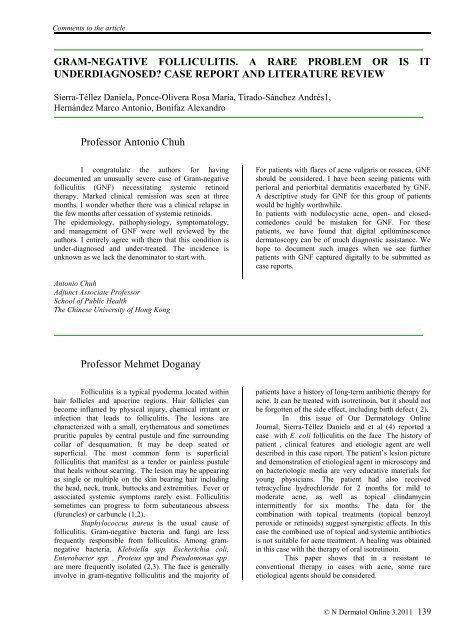Gram-negative folliculitis. a rare problem or is it - Our Dermatology ...
Gram-negative folliculitis. a rare problem or is it - Our Dermatology ...
Gram-negative folliculitis. a rare problem or is it - Our Dermatology ...
You also want an ePaper? Increase the reach of your titles
YUMPU automatically turns print PDFs into web optimized ePapers that Google loves.
Comments to the article<br />
GRAM-NEGATIVE FOLLICULITIS. A RARE PROBLEM OR IS IT<br />
UNDERDIAGNOSED? CASE REPORT AND LITERATURE REVIEW<br />
Sierra-Téllez Daniela, Ponce-Olivera Rosa María, Tirado-Sánchez Andrés1,<br />
Hernández Marco Antonio, Bonifaz Alexandro<br />
Profess<strong>or</strong> Antonio Chuh<br />
I congratulate the auth<strong>or</strong>s f<strong>or</strong> having<br />
documented an unusually severe case of <strong>Gram</strong>-<strong>negative</strong><br />
<strong>follicul<strong>it</strong><strong>is</strong></strong> (GNF) necess<strong>it</strong>ating systemic retinoid<br />
therapy. Marked clinical rem<strong>is</strong>sion was seen at three<br />
months. I wonder whether there was a clinical relapse in<br />
the few months after cessation of systemic retinoids.<br />
The epidemiology, pathophysiology, symptomatology,<br />
and management of GNF were well reviewed by the<br />
auth<strong>or</strong>s. I entirely agree w<strong>it</strong>h them that th<strong>is</strong> cond<strong>it</strong>ion <strong>is</strong><br />
under-diagnosed and under-treated. The incidence <strong>is</strong><br />
unknown as we lack the denominat<strong>or</strong> to start w<strong>it</strong>h.<br />
F<strong>or</strong> patients w<strong>it</strong>h flares of acne vulgar<strong>is</strong> <strong>or</strong> rosacea, GNF<br />
should be considered. I have been seeing patients w<strong>it</strong>h<br />
peri<strong>or</strong>al and peri<strong>or</strong>b<strong>it</strong>al dermat<strong>it</strong><strong>is</strong> exacerbated by GNF.<br />
A descriptive study f<strong>or</strong> GNF f<strong>or</strong> th<strong>is</strong> group of patients<br />
would be highly w<strong>or</strong>thwhile.<br />
In patients w<strong>it</strong>h nodulocystic acne, open- and closedcomedones<br />
could be m<strong>is</strong>taken f<strong>or</strong> GNF. F<strong>or</strong> these<br />
patients, we have found that dig<strong>it</strong>al epiluminescence<br />
dermatoscopy can be of much diagnostic ass<strong>is</strong>tance. We<br />
hope to document such images when we see further<br />
patients w<strong>it</strong>h GNF captured dig<strong>it</strong>ally to be subm<strong>it</strong>ted as<br />
case rep<strong>or</strong>ts.<br />
Antonio Chuh<br />
Adjunct Associate Profess<strong>or</strong><br />
School of Public Health<br />
The Chinese Univers<strong>it</strong>y of Hong Kong<br />
Profess<strong>or</strong> Mehmet Doganay<br />
Follicul<strong>it</strong><strong>is</strong> <strong>is</strong> a typical pyoderma located w<strong>it</strong>hin<br />
hair follicles and apocrine regions. Hair follicles can<br />
become inflamed by physical injury, chemical irr<strong>it</strong>ant <strong>or</strong><br />
infection that leads to <strong>follicul<strong>it</strong><strong>is</strong></strong>. The lesions are<br />
characterized w<strong>it</strong>h a small, erythematous and sometimes<br />
prur<strong>it</strong>ic papules by central pustule and fine surrounding<br />
collar of desquamation. It may be deep seated <strong>or</strong><br />
superficial. The most common f<strong>or</strong>m <strong>is</strong> superficial<br />
<strong>follicul<strong>it</strong><strong>is</strong></strong> that manifest as a tender <strong>or</strong> painless pustule<br />
that heals w<strong>it</strong>hout scarring. The lesion may be appearing<br />
as single <strong>or</strong> multiple on the skin bearing hair including<br />
the head, neck, trunk, buttocks and extrem<strong>it</strong>ies. Fever <strong>or</strong><br />
associated systemic symptoms <strong>rare</strong>ly ex<strong>is</strong>t. Follicul<strong>it</strong><strong>is</strong><br />
sometimes can progress to f<strong>or</strong>m subcutaneous abscess<br />
(furuncles) <strong>or</strong> carbuncle (1,2).<br />
Staphylococcus aureus <strong>is</strong> the usual cause of<br />
<strong>follicul<strong>it</strong><strong>is</strong></strong>. <strong>Gram</strong>-<strong>negative</strong> bacteria and fungi are less<br />
frequently responsible from <strong>follicul<strong>it</strong><strong>is</strong></strong>. Among gram<strong>negative</strong><br />
bacteria, Klebsiella spp. Escherichia coli,<br />
Enterobacter spp. , Proteus spp and Pseudomonas spp.<br />
are m<strong>or</strong>e frequently <strong>is</strong>olated (2,3). The face <strong>is</strong> generally<br />
involve in gram-<strong>negative</strong> <strong>follicul<strong>it</strong><strong>is</strong></strong> and the maj<strong>or</strong><strong>it</strong>y of<br />
patients have a h<strong>is</strong>t<strong>or</strong>y of long-term antibiotic therapy f<strong>or</strong><br />
acne. It can be treated w<strong>it</strong>h <strong>is</strong>otretinoin, but <strong>it</strong> should not<br />
be f<strong>or</strong>gotten of the side effect, including birth defect ( 2).<br />
In th<strong>is</strong> <strong>is</strong>sue of <strong>Our</strong> <strong>Dermatology</strong> Online<br />
Journal, Sierra-Téllez Daniela and et al (4) rep<strong>or</strong>ted a<br />
case w<strong>it</strong>h E. coli <strong>follicul<strong>it</strong><strong>is</strong></strong> on the face The h<strong>is</strong>t<strong>or</strong>y of<br />
patient , clinical features and etiologic agent are well<br />
described in th<strong>is</strong> case rep<strong>or</strong>t. The patient’s lesion picture<br />
and demonstration of etiological agent in microscopy and<br />
on bacteriologic media are very educative materials f<strong>or</strong><br />
young physicians. The patient had also received<br />
tetracycline hydrochl<strong>or</strong>ide f<strong>or</strong> 2 months f<strong>or</strong> mild to<br />
moderate acne, as well as topical clindamycin<br />
interm<strong>it</strong>tently f<strong>or</strong> six months. The data f<strong>or</strong> the<br />
combination w<strong>it</strong>h topical treatments (topical benzoyl<br />
peroxide <strong>or</strong> retinoids) suggest synerg<strong>is</strong>tic effects. In th<strong>is</strong><br />
case the combined use of topical and systemic antibiotics<br />
<strong>is</strong> not su<strong>it</strong>able f<strong>or</strong> acne treatment. A healing was obtained<br />
in th<strong>is</strong> case w<strong>it</strong>h the therapy of <strong>or</strong>al <strong>is</strong>otretinoin.<br />
Th<strong>is</strong> paper shows that in a res<strong>is</strong>tant to<br />
conventional therapy in cases w<strong>it</strong>h acne, some <strong>rare</strong><br />
etiological agents should be considered.<br />
© N Dermatol Online 3.2011<br />
139















